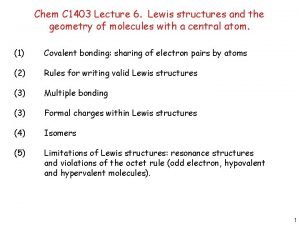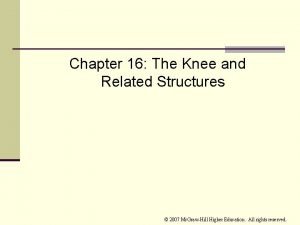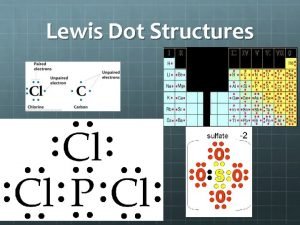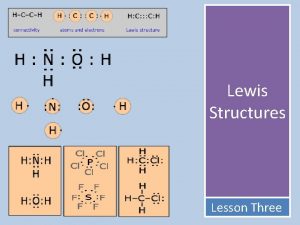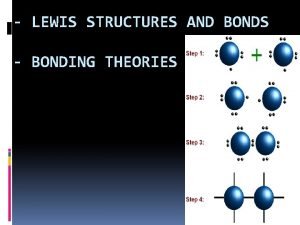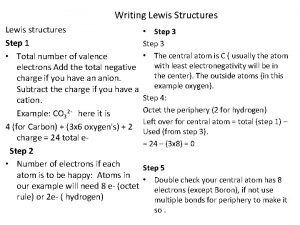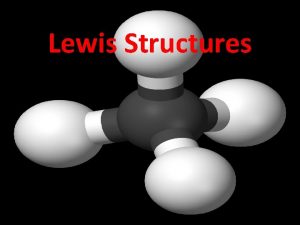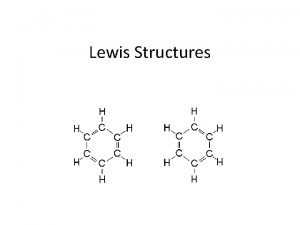Chapter 13 Lewis Structures Lewis Structures Lewis structures


























- Slides: 26

Chapter 13 Lewis Structures

Lewis Structures • Lewis structures are diagrams that show the bonding between atoms of a molecule, and the lone pairs of valence electrons in the molecule.





Steps for Writing Lewis Structures 1. Count the total number of outer level (valence) electrons. To do this use the Roman numeral from the group number above each element in the periodic table. • PO 43+

Steps for Writing Lewis Structures 2. Determine the layout of the molecule. The formula of the molecule will often give you a hint as to its layout. For example in the molecule H 3 CCH 3 there are two carbon atoms in the center with three hydrogen atoms bonded to each carbon. Carbon is always central Hydrogen is never central The element with the lowest electronegativity is central The element which you have the least of is usually central Group 17 elements are usually not central (unless you have no other choice) because they can only form single bonds. • • • – After determining the layout of the molecule. Arrange the elements symmetrically around your central atom(s).

Steps for Writing Lewis Structures 3. The valence electrons from step 1 are now used to stabilize the atoms. This is done by using shared pairs (bonds) (see Table 1) to attach the atoms to the central atom. Use single bonds for all atoms first. Note the strengths and lengths of the different types of bonds.

Steps for Writing Lewis Structures 3. After adding single bonds you may find that the atoms still need more valence electrons to achieve their octets. If more valence electrons are needed use unshared pairs (lone pairs) (see Table 1) around each atom to give the atom an octet (8 valence electrons). There are some exceptions to the octet rule. The most common exception is hydrogen which only requires 2 electrons to fill its outer level and become stable.

Steps for Writing Lewis Structures 3. The valence electrons from step 1 are now used to stabilize the atoms. This is done by using shared pairs (bonds) (see Table 1) to attach the atoms to the central atom. Use single bonds for all atoms first. • After adding single bonds you may find that the atoms still need more valence electrons to achieve their octets. If more valence electrons are needed use unshared pairs (lone pairs) (see Table 1) around each atom to give the atom an octet (8 valence electrons). There are some exceptions to the octet rule. The most common exception is hydrogen which only requires 2 electrons to fill its outer level and become stable. • If you still do not have a stable structure you may try double and triple bonds if C, N, or O is involved in the bond.

Steps for Writing Lewis Structures 4. If you cannot write a stable structure for the molecule using rules 1 – 3 add or remove unshared pairs to/from the central atom until you arrive at the desired number of valence electrons determined in step 1. This may give you a structure that appears to be unstable however some molecules can form which do not have stable octets. • Common exceptions to the octet rule: H is stable with 2 valence electrons; B is stable with 6 valence electrons.

Writing Lewis Structures CO 2

Writing Lewis Structures PO 4 3 -

Writing Lewis Structures H 2 CO

Writing Lewis Structures Br. NO

Writing Lewis Structures Br. NO

Steps for Writing Lewis Structures 2. Determine the layout of the molecule. The formula of the molecule will often give you a hint as to its layout. For example in the molecule H 3 CCH 3 there are two carbon atoms in the center with three hydrogen atoms bonded to each carbon. Carbon is always central Hydrogen is never central The element with the lowest electronegativity is central The element which you have the least of is usually central Group 17 elements are usually not central (unless you have no other choice) because they can only form single bonds. • • • – After determining the layout of the molecule. Arrange the elements symmetrically around your central atom(s).

Writing Lewis Structures HCCH

Steps for Writing Lewis Structures 2. Determine the layout of the molecule. The formula of the molecule will often give you a hint as to its layout. For example in the molecule H 3 CCH 3 there are two carbon atoms in the center with three hydrogen atoms bonded to each carbon. Carbon is always central Hydrogen is never central The element with the lowest electronegativity is central The element which you have the least of is usually central Group 17 elements are usually not central (unless you have no other choice) because they can only form single bonds. • • • – After determining the layout of the molecule. Arrange the elements symmetrically around your central atom(s).

Writing Lewis Structures HCCH

Writing Lewis Structures HCCH

Writing Lewis Structures Be. Cl 2

Steps for Writing Lewis Structures 4. If you cannot write a stable structure for the molecule using rules 1 – 3 add or remove unshared pairs to/from the central atom until you arrive at the desired number of valence electrons determined in step 1. This may give you a structure that appears to be unstable however some molecules can form which do not have stable octets.

Homework Lewis Structures Worksheet

Homework Lewis Structures Worksheet
 Homologous structures
Homologous structures Lewis structure li
Lewis structure li Rules for drawing lewis structures
Rules for drawing lewis structures K bohr rutherford diagram
K bohr rutherford diagram Polyatomic ion lewis structures
Polyatomic ion lewis structures Expanded octet lewis structure
Expanded octet lewis structure Lewis structure hcn
Lewis structure hcn Dicarbon tetrahydride lewis structure
Dicarbon tetrahydride lewis structure Lewis dot shapes
Lewis dot shapes Unit 8 ap chemistry
Unit 8 ap chemistry Lewis structures and molecular geometry
Lewis structures and molecular geometry Ps2-1 lewis structure
Ps2-1 lewis structure No+ lewis structure
No+ lewis structure Organizing in management
Organizing in management Lesson quiz 7-1 market structures
Lesson quiz 7-1 market structures Chapter 7 section 3 structures and organelles
Chapter 7 section 3 structures and organelles Knee anatomy chapter 16 worksheet 1
Knee anatomy chapter 16 worksheet 1 Chapter 16 worksheet the knee and related structures
Chapter 16 worksheet the knee and related structures Chapter 7 organizational structures
Chapter 7 organizational structures Data structures chapter 1
Data structures chapter 1 Chapter 7 market structures vocabulary
Chapter 7 market structures vocabulary Barriers to entry for perfect competition
Barriers to entry for perfect competition Chapter 7 section 3 structures and organelles
Chapter 7 section 3 structures and organelles Summary of bud, not buddy chapter 11
Summary of bud, not buddy chapter 11 The red tent book summary
The red tent book summary The great gatsby chapter 8 short summary
The great gatsby chapter 8 short summary Chapter 10 chapter assessment chemical reactions answers
Chapter 10 chapter assessment chemical reactions answers






